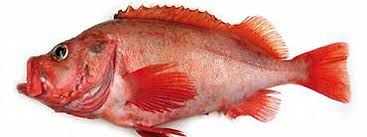Golden Redfish

Species Details
Sebastes Norvegicus
Sebastidae
Scorpaeniformes
nearshore, reefs, bottom fishing
8 - 33 lbs.
10" - 42"
Golden Redfish (Sebastes norvegicus) Fish Description
The Golden Redfish (Sebastes norvegicus) is a slow growing rockfish found all throughout the North Atlantic Ocean. It is a slow growing fish in that they reach maturity at a late age as compared to other fish species; although they have been known to live a really long time, with some even reaching seventy-five years of age.
The Golden Redfish got its name from its reddish to orange color that looks rather golden when it’s underwater. Most of its body has that striking orange color except for the white belly. Aside from its distinctive coloration, this fish can easily be recognized through its large, protruding eyes, pouty lips, bony gills, and its two-segment dorsal fin—with the front part spiky and the back a bit round. It also has relatively large pectoral fins while the pelvic and anal fins are small.
As mentioned above, the fish matures quite slowly, not reaching sexual maturity until it reaches around twelve to fifteen years. It is also a viviparous fish, which means its offspring are developed inside the body of the female and are born live. When the young are born, they would usually stay closer to the surface of shallow waters until they reach juvenile stage in which they would head to deeper waters.
Diet and Size
The Golden Redfish is a carnivore although it mostly eats planktons and fish larvae while it’s still young. It will, however, eat small fishes, small shellfish, crabs, and squids when it reaches adulthood.
The Golden Redfish can reach lengths of up to three and a half feet although most that are caught are just in the vicinity of fifteen to twenty inches. Little is known about their speed but they have been observed to be quite slow and sluggish most of the time. They can however be quick and agile in short bursts, especially when trying to escape a predator.
Golden Redfish Interesting Facts
- There have been recorded sightings of a Golden Redfish reaching almost three and a half in length and thirty-three pounds in weight.
- The oldest Golden Redfish on record is sixty years old.
- There were some unconfirmed individuals reaching one hundred years of age.
- Aside from humans, known predators include Atlantic Cods and bottom-dwelling sharks.
- The Golden Redfish is a popular food fish in Norway, Greenland, and Iceland, often fished commercially by these countries.
- Golden Redfish meat is tasty and healthy as it’s said to be rich in Omega-3 fatty acids as well as vitamin B12 and Selenium.
- Golden Redfish meat is sold filleted and frozen.
Fishing Tips
Because they tend to stay deep down in the ocean, you will have to use a weighted bait to be able to present your bait to your intended target. The fish is also quite easy to reel in so there’s no need for any specialized equipment to catch it—although you have to watch out for the rocks underwater as this fish will surely try to snag your line through some jagged rocks when you hook one.
Just to be sure, a short and lightweight rod paired with a conventional saltwater reel and a low-stretch braided line will help you better feel the bite, thus, you can react quicker. For bait, you can either use artificial lures or fresh baits (alive or dead)—it doesn’t really matter as this fish will certainly try to grab whatever bait you have in you. If you decide to go for fresh baits, anchovies, sardines, or squid strips have been known to be very effective. If you’re going for artificial lures, plastic lures such as scampi tails or a metal butterfly jig will work wonders.
Habitat and Distribution
The Golden Redfish can be found off the coasts of Northern Europe as well as near the shores of eastern North America—from Canada to the northern part of the US Atlantic waters. As a demersal fish, it stays close to the ocean floor, most commonly in depths between three hundred to more than a thousand feet. It also prefers colder waters and rocky underwater terrains.






